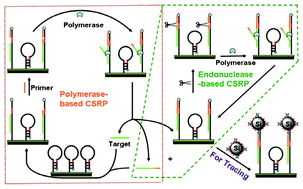Sensitive fluorescence detection of DNA using isothermal exponential amplification coupled quantum dots coated silica nanospheres as label†
Abstract
A new strategy to combine isothermal exponential amplification (IEA) with CdTe quantum dots (QDs) functionalized silica nanospheres as a label was designed for highly sensitive fluorescent detection of target DNA. A well plate was used as a support to immobilize a molecular beacon (MB) as a recognition probe and perform the IEA procedure. After the MB recognized target DNA and opened its cycle, the stem part could hybridize with a primer to initiate the polymerization of the DNA strand, which led to the release of target to open another MB molecule and start the next cycle of strand-replacement polymerization. Meanwhile, the formed double-stranded DNA was recognized by nicking endonuclease, leading to an endonuclease-based strand-replacement polymerization, which produced a DNA trigger to open more MB. The opened MB molecules were finally bound to the label by biotin–streptavidin coupling. Upon a dissolving process, the released cadmium cation could sensitize the fluorescent emission of Rhod-5N to achieve cascade signal amplification. The proposed method could detect target DNA ranging from 10−17 to 10−11 mol L−1 with a detection limit down to ∼50 copies. It also showed high selectivity. This highly sensitive and specific assay has potential to become a promising DNA quantification method in biomedical research and clinical diagnosis.


 Please wait while we load your content...
Please wait while we load your content...